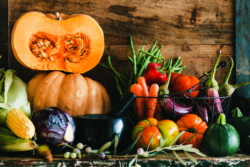Top Tips for Storing Crops
 What do you do with a bounty of crops? Here’s our top tips for what to do when you can’t eat another courgette muffin…
What do you do with a bounty of crops? Here’s our top tips for what to do when you can’t eat another courgette muffin…
1. Mid to late season apples and pears can be stored for up to three months in the right conditions. A cool place to store them is the key – a garage, shed, basement or cellar is ideal. The other key is good air movement. Layer your fruit in crates (or anything like crates) with recycled material (like cardboard) between layers. Make sure the fruit doesn’t touch. Check regularly.
2. Root crops (except potatoes) store really well, as they are meant to store energy for the plant’s second year of growth. Remove excess soil, but don’t scrub, and remove leaves by twisting off close to crown. Place in shallow boxes separating layers with a slightly damp packing material such as sand or coir.
3. Potatoes – should be stored in dry and dark conditions. Remove any damaged or rotten ones, knock off excess soil and leave out to dry for a few hours. Store in paper bags in a dark place at between 5-10 degrees Celsius.
4. Make cubes! Green veg (such as spinach) and herbs can be easily stored by chopping up and storing in ice cube trays in olive oil, coconut oil or just water.
5. On the topic of the freezer, some fruit and vegetables really suit freezing, and others don’t! Freeze when just ripe, as soon as possible after harvesting. And, remember to do it in quantities that will be easy to manage and defrost in the future! Some fruit and vegetables need blanching before freezing. The following list is by no means exhaustive, but all work well when frozen; raspberries, blueberries, blanched apples, blanched beans (including runner and French), gooseberries, peas, rhubarb.
